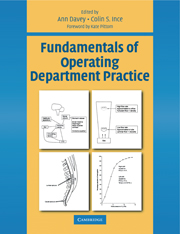Book contents
- Frontmatter
- Contents
- Contributors
- Preface
- Foreword
- Acknowledgements
- Introduction
- Chapter 1 The operating department practitioner, the patient and the law
- Chapter 2 Aspects of health and safety in the operating department
- Chapter 3 The caring practitioner
- Chapter 4 Strategies for infection control in the operating department
- Chapter 5 Sterilization, decontamination and the surgical field
- Chapter 6 The fundamentals of cardiovascular physiology
- Chapter 7 Fundamentals of respiratory physiology
- Chapter 8 Scientific principles in relation to the anaesthetic machine
- Chapter 9 Fundamentals of artificial ventilation of the lung
- Chapter 10 Scientific principles in relation to monitoring equipment
- Chapter 11 Scientific principles in relation to endoscopic, laser and radiological equipment
- Chapter 12 Pharmacological principles of drug administration
- Chapter 13 The pharmacology of drugs used in general anaesthesia
- Chapter 14 The local anaesthetic drugs - does the ideal agent exist?
- Chapter 15 The safe positioning of patients for surgery
- Chapter 16 Principles involved in the management and use of equipment
- Chapter 17 Understanding suture materials
- Chapter 18 Fundamentals ofpaediatric surgery and anaesthesia
- Chapter 19 Fundamentals of hyperthermia and hypothermia
- Chapter 20 Fundamentals of fluid and electrolyte balance during surgery
- Chapter 21 The physiology of blood and its administration
- Chapter 22 Fundamentals of pain relief
- Chapter 23 Fundamentals of dressings and drains in relation to wound healing
- Chapter 24 The recovery of patients from anaesthesia and surgery
- Chapter 25 Fundamentals of emergency and obstetric anaesthesia
- Chapter 26 Identification and management of anaesthetic emergencies
- Chapter 27 The fundamentals of emergency resuscitation
- Appendixes
- Index
Chapter 17 - Understanding suture materials
Published online by Cambridge University Press: 05 October 2015
- Frontmatter
- Contents
- Contributors
- Preface
- Foreword
- Acknowledgements
- Introduction
- Chapter 1 The operating department practitioner, the patient and the law
- Chapter 2 Aspects of health and safety in the operating department
- Chapter 3 The caring practitioner
- Chapter 4 Strategies for infection control in the operating department
- Chapter 5 Sterilization, decontamination and the surgical field
- Chapter 6 The fundamentals of cardiovascular physiology
- Chapter 7 Fundamentals of respiratory physiology
- Chapter 8 Scientific principles in relation to the anaesthetic machine
- Chapter 9 Fundamentals of artificial ventilation of the lung
- Chapter 10 Scientific principles in relation to monitoring equipment
- Chapter 11 Scientific principles in relation to endoscopic, laser and radiological equipment
- Chapter 12 Pharmacological principles of drug administration
- Chapter 13 The pharmacology of drugs used in general anaesthesia
- Chapter 14 The local anaesthetic drugs - does the ideal agent exist?
- Chapter 15 The safe positioning of patients for surgery
- Chapter 16 Principles involved in the management and use of equipment
- Chapter 17 Understanding suture materials
- Chapter 18 Fundamentals ofpaediatric surgery and anaesthesia
- Chapter 19 Fundamentals of hyperthermia and hypothermia
- Chapter 20 Fundamentals of fluid and electrolyte balance during surgery
- Chapter 21 The physiology of blood and its administration
- Chapter 22 Fundamentals of pain relief
- Chapter 23 Fundamentals of dressings and drains in relation to wound healing
- Chapter 24 The recovery of patients from anaesthesia and surgery
- Chapter 25 Fundamentals of emergency and obstetric anaesthesia
- Chapter 26 Identification and management of anaesthetic emergencies
- Chapter 27 The fundamentals of emergency resuscitation
- Appendixes
- Index
Summary
INTRODUCTION
Put most simplistically, operative surgery consists of nothing more than cutting the body's tissues and subsequently sewing them back together again. Therefore to the uninitiated it probably seems that the whole issue of suture materials is simple to understand. There are, however, probably few surgical subjects that generate as much heated debate as the ‘correct’ use of the ‘appropriate’ suture in a particular clinical situation. All surgeons have their own opinions as to the ideal suture material for each situation but sadly this is a decision that is often based on habit, tradition or whim. Surgeons thus empirically find the suture material which best suits them. Therefore different surgeons will often use quite different materials and dimensions of sutures for the same purpose. With increasing knowledge about the physical properties of different suture materials and the tissue reactions to these materials, it becomes increasingly clear that for a given purpose one suture or type of suture is often far more suitable than others are.
The purpose of this chapter is therefore to guide the reader through the suture options available, whilst outlining some of the reasons why the diffuse variety of sutures and needles needs to exist.
THE HISTORY OF SUTURE MATERIALS
The use of thread for wound closure and for ligature is described in the literature as far back as 2000 BC. Since then a great many materials have been used for these purposes, including dried gut, dried tendon, strips of hide, horsehair, women's hair, bark fibres and textile fibres of various kinds. The Greeks were leaders in the field of medicine and the Romans later adopted their techniques. Galen, in the second century AD, used silk and harp cord for ligatures as well as strands of animal intestine to close the wounds of Roman gladiators. In the 10th century Rhazes is credited with being the first to stitch abdominal wounds with harp strings made from spun strands cut from animal intestines.
Before the introduction of antisepsis the use of sutures and ligatures presented great problems since their application almost invariably resulted in infection. Pus formation and secondary haemorrhage were therefore common complications. The introduction of antisepsis by Lister in 1867 resulted in a considerable improvement in the infection rate.
- Type
- Chapter
- Information
- Fundamentals of Operating Department Practice , pp. 187 - 194Publisher: Cambridge University PressPrint publication year: 1999

